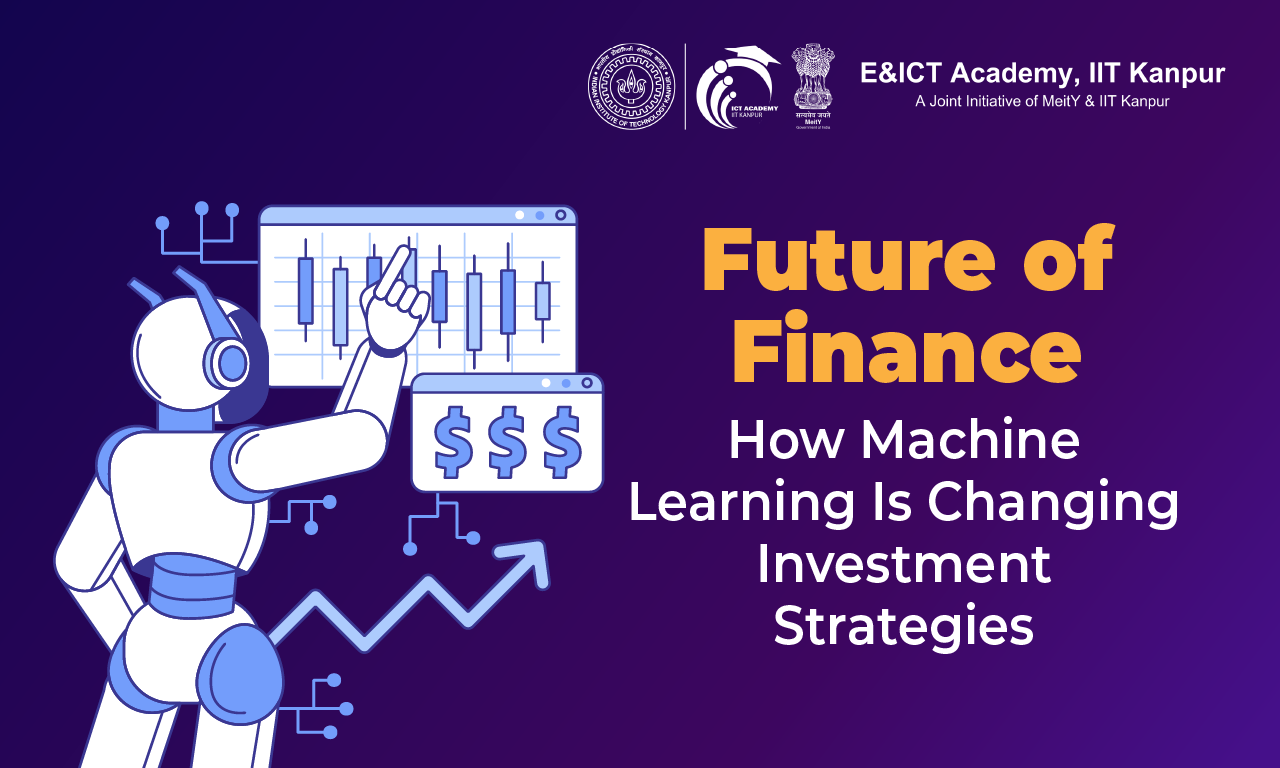Future of Finance: How Machine Learning Is Changing Investment Strategies

A world where milliseconds can decide the fate of market winners and losers no longer relies just on instinct, but on intelligent algorithms.
Data is not just an asset in the evolving financial world; it’s the edge. Trillions of dollars move across the financial markets every day, and financial market participants strive to process, analyze, and act on information faster than their competitors, which is key to investment success. The core of this transformation? Machine learning. It’s rapidly reshaping how investments are made with smart predictions, real-time techniques, and razor-sharp market responsiveness across international financial ecosystems.
Let’s understand the future of finance, where algorithms learn, portfolios respond, and insights are born out of computation and not intuition.
Evolution of Investment Strategies: How Intuition Switches to Intelligence
For decades, investment strategies have taken their bearings from fundamental analysis (examining financial statements and earnings, as well as macroeconomic data) and technical analysis (price movement and chart momentum indicators). To some extent, these practices still exist but are interpreted by humans and prone to cognitive bias, decisions influenced by human emotions, and inconsistent applications.
Expertise in machine learning represents a data-centric alternative. By training algorithms with massive datasets, investors could now detect patterns, correlations, and anomalies that far exceed human capacity. This means moving from intuition-based investing to intelligence-based decision-making, placing companies in an advantageous position to build evolving models.
Core Applications of Machine Learning in Investment
1. Predictive Analytics
Predictive analytics in businesses is the forecasting of market behavior, a brilliant application reflecting the power of ML. Algorithms can ingest financial indicators, sentiment measures, and macroeconomic trends to arrive at price level estimates. For example, LSTM (Long Short-Term Memory) neural networks are popularly employed in modeling time-series financial data, predicting market trend developments as they grow more accurately.
2. Portfolio Optimization
The models working on machine learning rebalance portfolios dynamically by responding to changing market conditions through different ML predictors. They also process portfolios with a focus on obtaining the highest returns possible with the least risk through techniques like Bayesian optimization or Monte Carlo simulation.
3. Fraud Detection and Compliance
In a world where milliseconds count and billions are in play, the detection of anomalies holds primary importance. Unsupervised machine learning models are deployed to spot any unusual trading activity, which might be flagged for clear potential breaches of regulations or fraud, keeping a lid on regulatory risks.
4. Algorithmic and High-Frequency Trading
Thanks to ML algorithms, thousands of positions can be traded in just a few moments. Reinforcement learning agents optimize trade execution while learning from the market environment itself. These constantly self-improving agents excel beyond traditional rule-based systems since they never stop learning and adapting to new information.
Data as the New Alpha: Importance of Big Data
Machine learning heavily relies on big data, not only quantity but also variety and velocity. Today, financial models ingest not only structured data, such as balance sheets or stock prices, but also unstructured data from social media, earnings call transcripts, and news reports.
Natural Language Processing (NLP)
For NLP, machines can study the sentiment of tweets, blogs, and headlines in real-time while absorbing the market mood. Hedge funds and investment banks adjust their exposure based on public perception or breaking news.
Alternative Data Sources
From satellite images gauging oil storage levels to anonymized credit-card transaction data, ML can add unorthodox data to generate hidden alpha. The incorporation of these additional data sources creates a rift between traditional, conventional strategies and advanced ones.
Reinforcement Learning: The Next Frontier
Reinforcement learning, an arm of ML where agents learn from rewards and penalties to optimize actions, is becoming popular in trading.
RL-based strategies are dynamic as they learn from market feedback. For example, agents have been created by firms to trade positions on comparatively adverse volatility, volume, and risk signals with better Sharpe ratios than older strategies. Rather than supervised learning, RL fits in a real-world financial environment better because of the sequencing of decisions.
Challenges in Integrating ML into Investment Strategies
While ML offers powerful tools, its implementation in finance isn’t without hurdles:
- Data Quality & Overfitting: Financial data tends to be noisy and sparse. With poor data preprocessing, models can overfit and exhibit excellent results on testing data but fail miserably when going live.
- Model Interpretability: Regulatory frameworks of the sort that include Basel III or MiFID II require an explanation for every trading decision, while many ML models, specifically deep neural networks, act as “black boxes,” thereby restricting transparency.
- Ethical and Privacy Issues: The use of alternative data has to comply with data protection laws such as the GDPR, and biases in model training could make predictions unfair.
Why Still Human Expertise in an ML-Driven Investment Ecosystem?
Human insight is essential, given the empowerment given by ML to finance. ML is just an augmentation tool and not a replacement for the financial analyst. It becomes imperative for human judgment to intervene as analysts interpret outputs, validate models, and make strategic decisions for which an understanding of macroeconomic and political contexts is required. This shift, therefore, gives rise to the requirement of learning financial engineering, quantitative analysis, and data science, individuals who form a bridge between finance and AI by combining domain knowledge with technical know-how to design, supervise, and fine-tune models that address business objectives, ethical concerns, and changing regulatory frameworks.
Moving Towards a Smarter Financial Future
Machine learning integration into investment strategies is not a buzzword—it’s a transformation. From intelligent forecasting to adaptive trading agents, ML is reshaping how capital is deployed, risk is measured, and opportunity is discovered.
With the passing of the last decade as an era for autonomous financial decision-making, individuals proficient in ML and data science will take the lead in the future of investing. Firms that embrace this transformation will not just survive but thrive in a market where algorithms often see what humans miss.
Trying to stay ahead in this AI-centric world of finance? Join the E&ICT Academy, IIT Kanpur, to learn Machine Learning and Finance—cutting-edge skills for the strategists of tomorrow.



